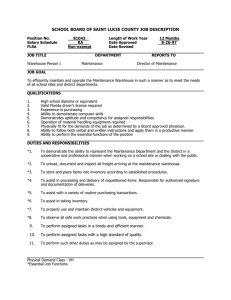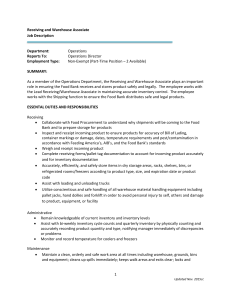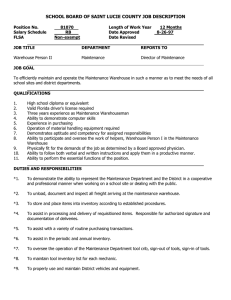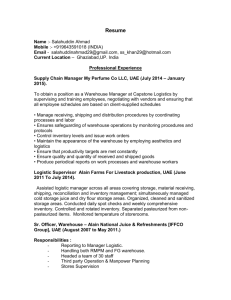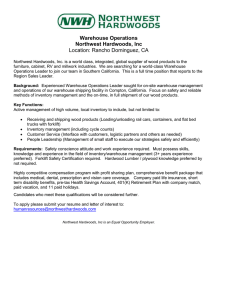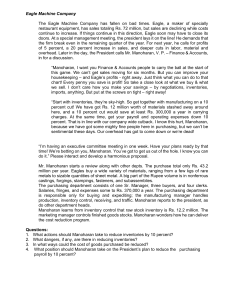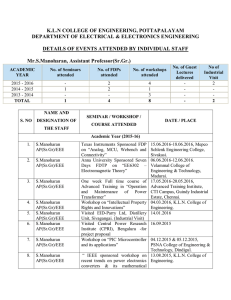Document 15504155
advertisement
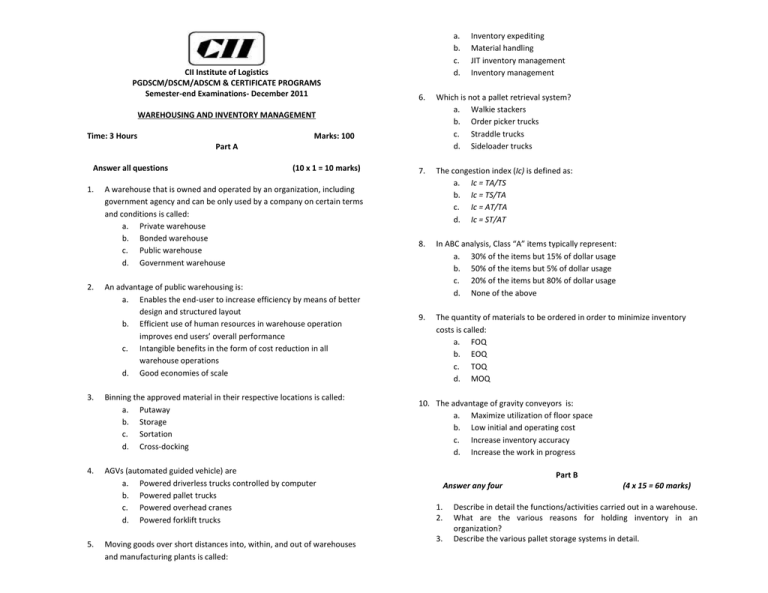
CII Institute of Logistics PGDSCM/DSCM/ADSCM & CERTIFICATE PROGRAMS Semester-end Examinations- December 2011 a. b. c. d. 6. Which is not a pallet retrieval system? a. Walkie stackers b. Order picker trucks c. Straddle trucks d. Sideloader trucks 7. The congestion index (Ic) is defined as: a. Ic = TA/TS b. Ic = TS/TA c. Ic = AT/TA d. Ic = ST/AT 8. In ABC analysis, Class “A” items typically represent: a. 30% of the items but 15% of dollar usage b. 50% of the items but 5% of dollar usage c. 20% of the items but 80% of dollar usage d. None of the above 9. The quantity of materials to be ordered in order to minimize inventory costs is called: a. FOQ b. EOQ c. TOQ d. MOQ WAREHOUSING AND INVENTORY MANAGEMENT Time: 3 Hours Marks: 100 Part A Answer all questions 1. 2. (10 x 1 = 10 marks) A warehouse that is owned and operated by an organization, including government agency and can be only used by a company on certain terms and conditions is called: a. Private warehouse b. Bonded warehouse c. Public warehouse d. Government warehouse An advantage of public warehousing is: a. Enables the end-user to increase efficiency by means of better design and structured layout b. Efficient use of human resources in warehouse operation improves end users’ overall performance c. Intangible benefits in the form of cost reduction in all warehouse operations d. Good economies of scale 3. Binning the approved material in their respective locations is called: a. Putaway b. Storage c. Sortation d. Cross-docking 4. AGVs (automated guided vehicle) are a. Powered driverless trucks controlled by computer b. Powered pallet trucks c. Powered overhead cranes d. Powered forklift trucks 5. Moving goods over short distances into, within, and out of warehouses and manufacturing plants is called: Inventory expediting Material handling JIT inventory management Inventory management 10. The advantage of gravity conveyors is: a. Maximize utilization of floor space b. Low initial and operating cost c. Increase inventory accuracy d. Increase the work in progress Part B Answer any four 1. 2. 3. (4 x 15 = 60 marks) Describe in detail the functions/activities carried out in a warehouse. What are the various reasons for holding inventory in an organization? Describe the various pallet storage systems in detail. 4. 5. 6. Give overview of RFID technology and its applications in a warehouse. Explain about bar coding systems and their applications in the logistics industry. What are the different types of conveyors used in a warehouse? Describe them briefly. Part C Case study (3*10=30 marks) Please read the case and answer the questions given below: The Eagle Machine Company has fallen on bad times. Eagle, a maker of specialty restaurant equipment, has sales totaling Rs.72 million. But sales are declining while costs continue to increase. If things continue in this direction, Eagle may soon have to close its doors. At a special management meeting, the president lays it on the line! He demands that the firm break even in the remaining quarter of the year. For next year, he calls for 5 percent profits, a 20 percent increase in sales, and deeper cuts in labor, material and overhead. Later in the day, the president calls Mr.Manoharan, V.P. - Finance & Accounts, in for a discussion. “Manoharan, I want you, Finance & Accounts people to carry the ball at the start of this game. We can’t get sales moving for six months. But you can improve your housekeeping- and Eagles profit-right away. Just think what you can do to that chart! Every penny you save is profit! So take a close look at what we buy & what we sell. I don’t care how you make your savings –by negotiations inventories, imports, anything. But put the screws on tight-right away. “Start with inventories, they‘re Sky high. So get together with manufacturing on a 10 percent cut! We have got Rs.12 million worth of materials stashed away around here, and a percent cut would save at least Rs. 300,000 a year in carrying charges. At the same time, get your payroll and operating expenses down 10 percent .That’s in line with our company wide cut back. I know this hurts, Manoharan, because we have got some mighty fine people here in purchasing, but we can’t be sentimental these days. Our over head has got to come down or we’re dead! “I’ m having an executive committee meeting in one week. Have your plans ready by that time! We’re betting on you, Manoharan. You have got to get us out of the hole. I know you can do it. Please interact and develop a harmonious proposal” Mr. Manoharan starts a review along with other depts. The purchases total only Rs. 43.2 million per year. Eagle buy, a wide variety of materials, ranging from a few kgs of rare metals to sizable quantities of metal sheet. A big part of the Rupee volume is in non-ferrous castings, forgings, stampings, fasteners and sub-assemblies. The purchasing department consists of one Sr. Manager, three buyers, and four clerks. Salaries, fringes and expenses sum to Rs.370,000 a year. The purchasing department is responsible only for buying and expediting; the manufacturing manager handles production, inventory control, receiving and traffic. Manoharan reports to the president, as do other department heads. Manoharan learns from inventory control that raw stock inventory is Rs. 12.2 million. The marketing manager controls finished goods stocks. Manoharan wonders how he can deliver the cost reduction program. Questions: 1. What actions should Manoharan take to reduce inventories by 10 percent? 2. What dangers, if any, are there in reducing inventories? 3. In what ways could the cost of goods purchased be reduced? ***************************************

